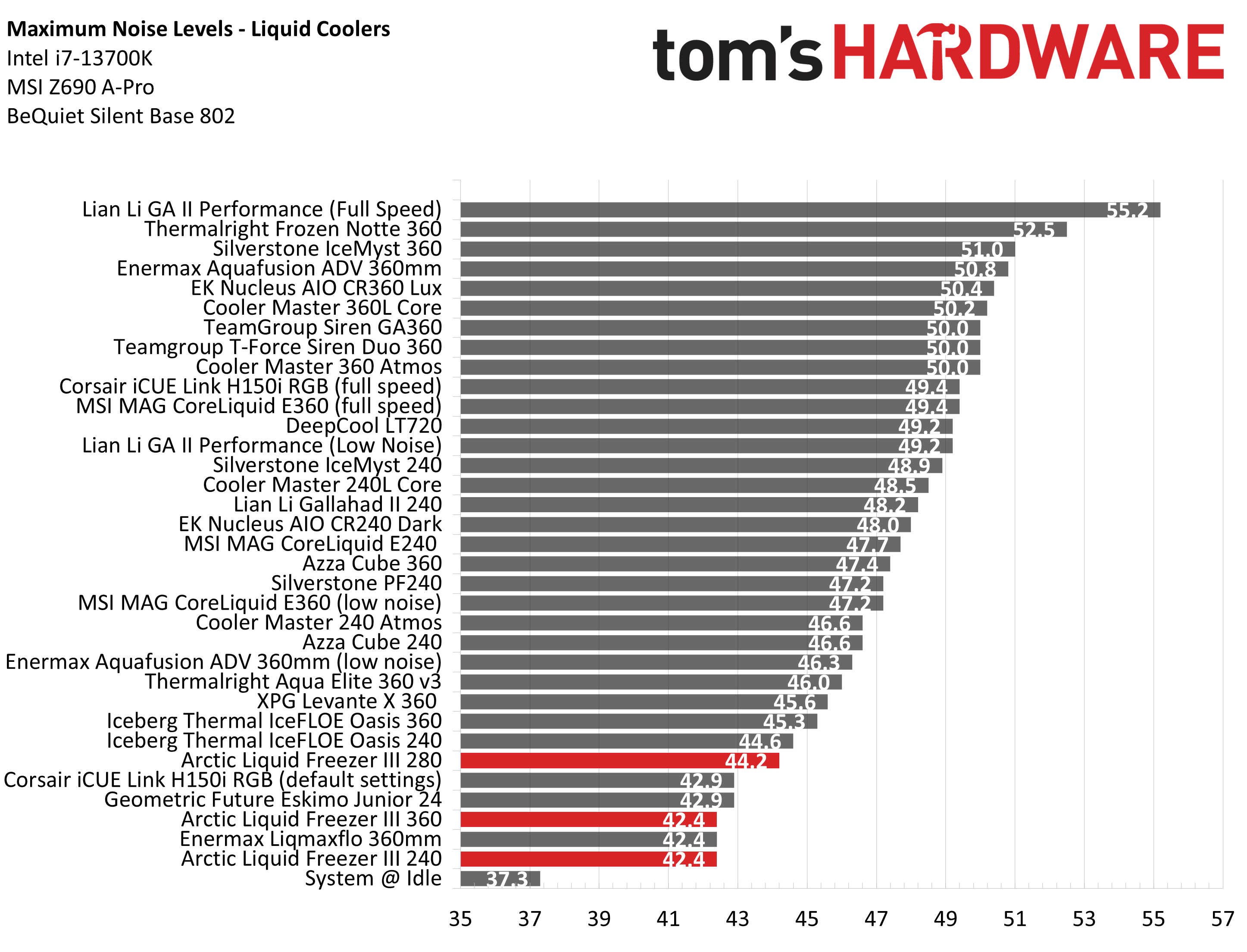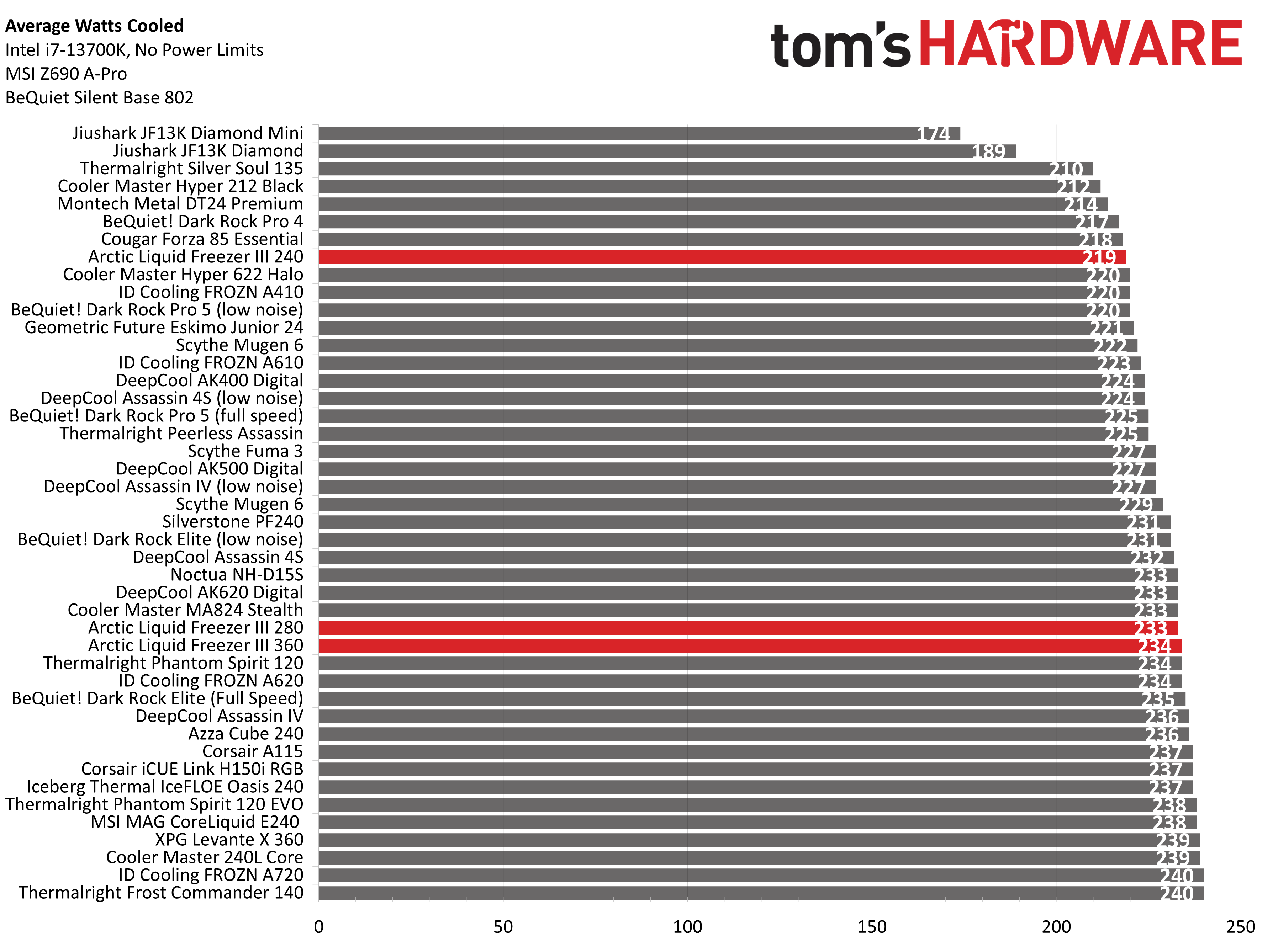Why you can trust Tom's Hardware
Thermal results without power limits
Without power limits enforced on Intel’s i7-13700K, the CPU will hit its peak temperature and thermally throttle with even the strongest of air coolers. When the CPU reaches its peak temperature, I’ve measured the CPU package power to determine the maximum wattage cooled to best compare their performance. The results below do not include the best liquid coolers on the market, which are able to keep the CPU under TJ Max (100C).
Disappointingly, all models of the Liquid Freezer III failed our testing with power limits removed, and caused minor thermal throttling of the CPU. If you look at their performance by total watts cooled, as shown in the chart below, you can see that the thermal performance of the two larger Liquid Freezers’ is similar to DeepCool’s AK620 air cooler.
On the other hand, compared to other AIOs, the Liquid Freezers do well in total noise levels – amongst the quietest in our charts. While normally I would be impressed by this, air coolers that offer similar thermal performance also offer similar noise levels. For example, DeepCool’s AK620 Digital has a maximum noise level of 43.4 dBA – compared to the 44.2 dBA recorded for the 280mm Liquid Freezer III and the 42.4 dBA for the 360mm version.


Thermal results with noise normalized to 38.2 dBA
Finding the right balance between fan noise levels and cooling performance is important. While running fans at full speed can improve cooling capacity to some extent, the benefits are limited and many users prefer a quiet system. With this noise-normalized test, I’ve set noise levels to 38.2 dBA. This level of noise is a low volume level, but slightly audible to most people.
Given how respected previous-generation Arctic AIOs are, I was hoping that the Liquid Freezer III would perform well when noise normalized, and that its previous lackluster results were simply a result of lower noise levels. But as our testing shows, that’s not the case.
When set to a low noise level of 38.2 dBA, the performance of the Liquid Freezer III is underwhelming. Iceberg Thermal’s recently released IceFLOE AIOs provide far superior performance in this test, and they’re priced similarly. The 240mm version of the Arctic cooler failed this test entirely, as it suffered from pump whine which caused the noise level to reach 39.6 dBA, even with fans set to run quietly.
175W Cinebench results
Most coolers on the market can keep Intel’s i7-13700K under its peak temperature if the power consumption is limited, so for this test, we’ll be looking at the CPU’s actual temperature.
Get Tom's Hardware's best news and in-depth reviews, straight to your inbox.
With a steady 175W load run on the CPU, the temperature averaged 55C over the ambient room temperature of 23 degrees C for the two larger Arctic coolers. This would be impressive for an air cooler, but for an AIO, it is rather lackluster. The results for all three Liquid Freezer coolers are among the worst I’ve seen for air coolers tested on this system.
That said, I generally consider noise levels more important here. Compared to other AIOs, the 360mm Liquid Freezer III does fairly well here – beaten only by Enermax LiqMaxFlo. If thermal performance was better than air coolers, this would be impressive. However, both thermal results and noise levels are similar to mid-range air coolers like DeepCool’s AK620.
125W Cinebench results
The lowest power limit I test with Raptor Lake CPUs is 125W. This is a high enough limit to allow the CPU to maintain its base clock speeds even in the most intensive tests, and most coolers should be capable of keeping the CPU below TJ Max (the max temperature before throttling) – even low-end coolers. The thermal performance of the Liquid Freezers in this scenario was middle of the road for liquid coolers, averaging 62C in an ambient temperature of 23C.
However, thermals do not matter in this scenario. Even Intel’s stock cooler can handle a load like this with ease. Noise levels, rather than CPU temperature, are the most important factor here. These reached 38.2 dBA for the 360mm model and 38.9 for the 280mm variant. These are relatively good noise levels for the two larger models, but I had expected even quieter noise levels.
Conclusion
After installing and testing models in three different sizes, I can’t recommend Arctic’s Liquid Freezer III AIOs, for a few different reasons.
- They fail maximum strength thermal tests
- The require the use of a warranty-voiding contact frame
- The deliver mediocre noise normalized performance
- Better options exist for the same price
- They don’t impress under the heat of Intel’s i7-13700K, performing similar to air coolers
In this price range, I’d recommend either Iceberg Thermal’s IceFLOE Oasis or Enermax’ LiqMaxflo AIOs instead, both of which offer superior thermal performance at similar noise levels.
With these unflattering results, I know a lot of you will be thinking about other reviews that have painted a rosier picture of these coolers. How is it that other, well-respected reviewers show Arctic’s latest to be performing fairly well, when our results are unflattering?
That comes down to testing methodology. You might see other reviews testing with older platforms, like Ryzen 3000. But I only test with the latest generations of CPUs for Tom’s Hardware cooling reviews, because older CPUs have lesser thermal density, making them generally easier to cool.

Albert Thomas is a contributor for Tom’s Hardware, primarily covering CPU cooling reviews.
-
-Fran- Come on Albert, I'm sure you're mad they bundled a contact frame and didn't let you use yours! :DReply
Joking aside, quite shocking to see these numbers. I'm guessing since you've always been testing with the contact frame, the fact they're bundling it gives them no real advantage over the others which rely on the normal ILM instead.
Would you have time or energy to re-test them in an AMD platform using whatever they bundle for it?
Regards, -
Albert.Thomas Reply
Unfortunately, no.-Fran- said:Would you have time or energy to re-test them in an AMD platform using whatever they bundle for it?
I don't think that the results would be significantly different and I'm behind on testing other products because of how much extra retesting this review took. -
UnforcedERROR This is a spectacular letdown, especially considering it's attractive relative to the previous version. It's somewhat baffling that a company who's been in the enthusiast space as long as Arctic would do so poorly on the follow-up to one of the highest recommended products in years. I'd gladly take a 3rd-gen "ugly" version of the performance was there, and obviously other people felt the same way about the 2nd-gen.Reply -
thestryker I'm a little disappointed in the results, but they're not really shocking to me. Hardware Canucks had it middle of the pack on their Intel testing, but towards the top on AMD. TPU also had it middle of the road on LGA1700. After seeing the GN review I can't help but wonder if the issue is the contact frame, but there's no way to find out (could try a LFII and if it performs better would answer that question to some degree). I understand why they went with the contact frame design, but I think it was a mistake just the same.Reply
The LFIII really strikes me as the best AMD choice and an average Intel choice. The discounted pricing would probably make it an okay Intel buy, but I don't think I'd buy one with regular pricing. -
RubberMallet I have the 420mm version of this installed on a 14900K. It is able to cool 5.7ghz multicore cinebench runs @ 290W in mid 80s, without any thermal throttling. (This is 15C better than my old AIO which would hit 100C under this load even with a contact frame.) By my estimation, it will cool 325W before throttling and do it quietly. It can cool 200W gaming loads silently.Reply
I dont understand how TH is getting thermal throttling at 230-235W with the 280/360 versions.
As you can see, they are the quietest in the test, which indicates the slowest fans. The best performing AIOs are also loudest, indicating higher power fans. If he tested the RGB versions, those fans are known to have lower rpm than the non-rgb and probably explains the results.
Could the stock fans be that bad? Is the goal to get buyers to purchase additional upgrade fans?
I have always trusted TH; this is the first article that leads me to question that trust. Even with the P12 argb fans, it is impossible to believe that a 360mm thermal throttles at 235W. Even the lowest, spec 360 AIOs from two generations ago did much better than that.
The noise/performance is as expected, but the low headroom is what is hard to believe. Did he have the fans/pump on 100% at max cpu load? The only way to explain this is tester error.
(The cooler a cpu is running, the less watts it will draw at a given clock speed. If the 13700K is maxed out and drawing 235W, that is better than a maxed out 13700K drawing 240W, which indicates it is running hotter. )
They don't list ambient temp (no calibration), so my guess is that their whole database of cooling results are not temp normalized, and worthless. -
35below0 Reply
Because your cooler didn't get a nice review?RubberMallet said:I have always trusted TH; this is the first article that leads me to question that trust. Even with the P12 argb fans, it is impossible to believe that a 360mm thermal throttles at 235W. Even the lowest, spec 360 AIOs from two generations ago did much better than that.
A few other reviews also showed LF III is underwhelming. TH methodology exposed it further.
There are limits to every test.
I'm not sure how you can use one result to completely lose trust. There's lots to criticise TH articles and reviews over, but you're burying results as worthless even though you have not tested the cooler in other configurations than your own.
The paranoia or accusations of steering users to upgrade packs or away from Arctic are werid.
In addition, the contact frame, price, socket support ar other things listed as cons. And those are not performance related.
Why am i even defending TH ? -
RubberMallet Reply
Its not that the results are bad, it is that they are so bad to defy explanation.35below0 said:Because your cooler didn't get a nice review?
A few other reviews also showed LF III is underwhelming. TH methodology exposed it further.
There are limits to every test.
Even a cheap 360 from two generations ago outperforms what they showed here.
I suspect their data is fragmented from different testers, different locations, and different understanding of what they are testing.
What I think happened is this:
A 360mm aio (even the worst) is not going to thermal throttle (100C) at 235W. It just won't. Reporting otherwise is misinformation.
What is probably happening is that the 13700K is maxed out at 5.2 multicore in their benchmark, and with the arctic LF3 is drawing 235W, and the "best" cooler is drawing ~240W.
At the same workload, a cooler CPU will consume less watts. So the LF3 might only need 235W to complete the workload, where another cooler might require 240W for the same workload.
At the bottom of the chart, you have junky single tower air coolers that are legitimately maxed out at 100C and unable to provide more.
Their assertion that it thermal throttles at 235W is like asserting that the earth is flat.






